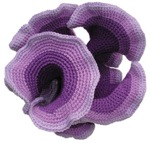 Mathematicians are used to working with knots, but now they're discovering knits, as well.
Mathematicians are used to working with knots, but now they're discovering knits, as well.
When you think of mathematical visualizations, computer graphics instantly spring to mind. However, even with the best 3D math, you're still viewing the graphics on a 2D surface which doesn't allow you to truly feel the object. According to Science News, mathematicians are discovering that knitting mathematical shapes and concepts helps researchers, teachers and students get a better sense of the surface qualities of the more unusual shapes.
If I talk about the mathematics of a plane, I can simply show you a piece of paper. For spherical geometry, I can use a baseball, basketball or a globe as an example. When I talk about hyperbolic geometry, in which surfaces grow exponentially as they extend out, what can I show you? For 2D hyperbolic geometry, I could show you Escher's Circle Limit III, but what about 3D?
This is why knitted models are so effective. They can be held in the hand and explored, and the surfaces can be colored to get across various concepts. If I were to hand you the model of a hyperbolic surface that is shown in the upper left corner of this post, and ask you which shade of purple used the most yarn to create, you would probably say that the darkest shade required the most yarn. Actually, due to the nature of this unusual surface, each shade uses the exact same amount of yarn!
Hyperbolic geometry isn't the only thing you can visualize with knitting, either. Various concepts such as the mathematics of toruses (doughnuts) and the Lorenz manifold, a concept from chaos theory, have been knitted. As a matter of fact, a recent competition concerning the crocheting of the Lorenz manifold attracted interest from numerous magazines and TV stations!
Interestingly, according to the article, there is even a book being planned for a spring 2007 release, called Making Mathematics with Needlework. While I might go for the knitted Moebius strip, I'm not so sure about the Klein bottle hat.
0
Related Posts
Subscribe to:
Post Comments (Atom)




No Response to "Knitting and Mathematics"
Post a Comment